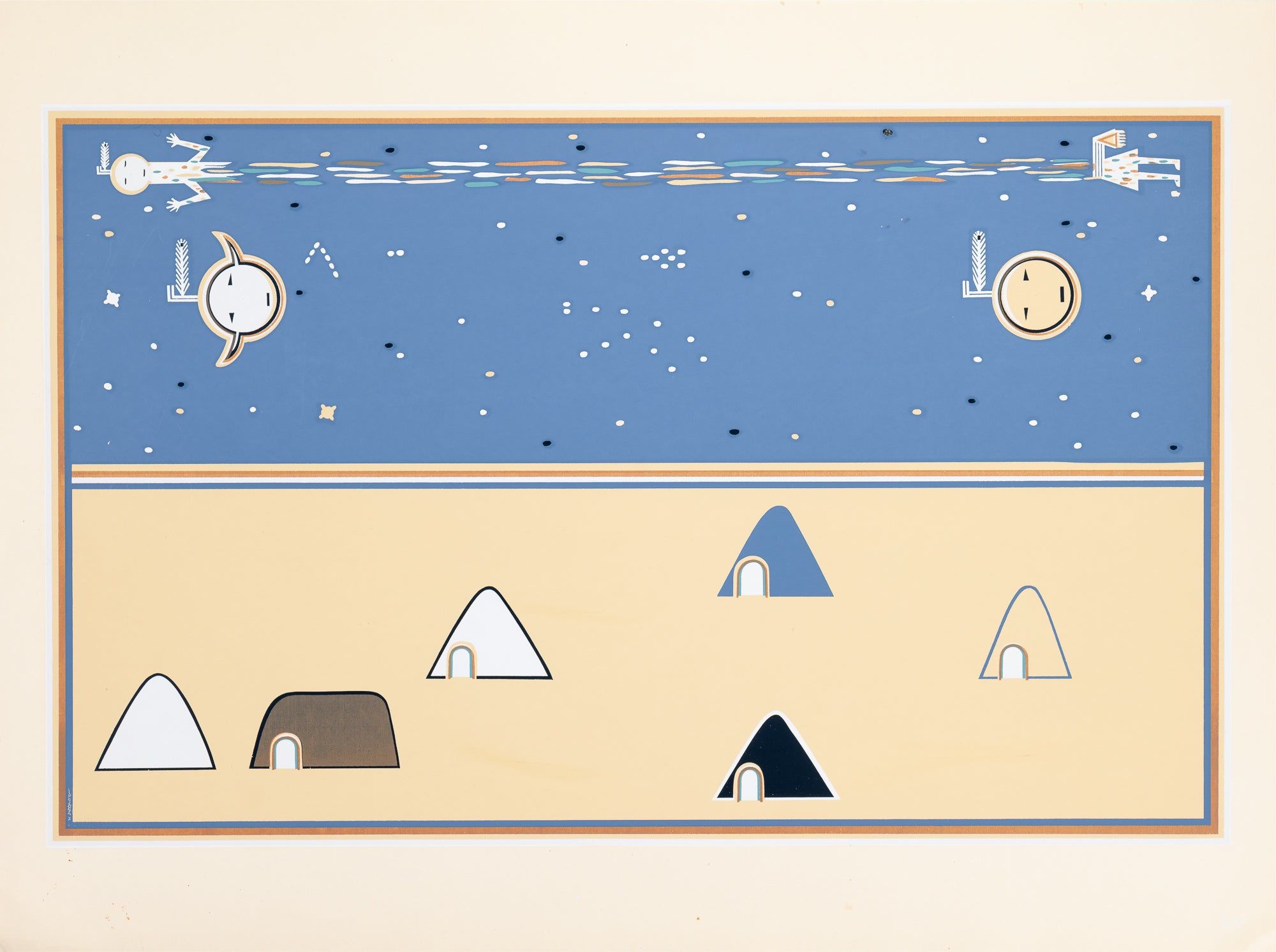Where the Two Came to Their Father; A Navaho War Ceremonial
- SIGNED
- New York: Bollingen Series I for Pantheon Books, 1943
New York: Bollingen Series I for Pantheon Books, 1943. First Edition. Near fine/near fine. Original cloth portfolio containing 18 silkscreen prints, all 18” x 23 7/8” and the 88 pp. book describing A Navajo War Ceremonial and commentary. Paper flaps on the portfolio are worn with some tears, silkscreens generally near fine but for some bent corners and light toning, book with a short tear to the top spine fold, else near fine. Not to be confused with the 1969 reprint. An extraordinary ethnographic collaboration preserving one of the most sacred ceremonials of the Navajo Nation, documented during World War II when Native Americans faced military conscription for the first time. This work emerged from the partnership between anthropologist Maud Oakes and Jeff King (Navajo name: Haska-zilth-e-yah), one of the twentieth century's most revered Navajo medicine men and former U.S. Army scout who would later be interred at Arlington National Cemetery.
King's own introduction reveals the ceremonial's profound spiritual purpose: "THIS STORY is the beginning of people. East, south, west, and north, it goes everywhere, because it is full of power—good power. My story has no evil in it. It is straight. It is to save and protect people. It is to save and protect men going to war, or in enemy country." The narrative chronicles the emergence of the Warrior Twins through a complex mythology beginning in primordial time when natural forces possessed consciousness and speech.
The eighteen sand paintings employ a sophisticated theological color system that functions as spiritual cartography, mapping the heroes' journey through zones of varying supernatural intensity. Campbell's analysis reveals three distinct color arrangements corresponding to different phases of the mythic quest. The standard Navajo sequence (white for east, blue for south, yellow for west, black for north) appears only in the fourteenth painting, which depicts heaven and earth in conventional terms, representing what Campbell calls "lower, or rather, natural potency."
The hero series itself employs a preternatural arrangement placing black in the east and white in the north, "a sequence...used in works against witches, enemy evils, and demons especially malignant." Seven paintings display this positive arrangement during moments when the twins hold spiritual advantage: their initial departure from home, their post-initiation empowerment, their final glorification, and the series depicting the Sun's House guardians. Most significantly, three paintings exhibit the mirror-reverse sequence during the quest's most perilous episodes: confronting the cosmic ocean, approaching the terrifying House of the Sun, and battling the chief of all monsters with solar assistance. In these climactic scenes, "the powers confronted are much greater than the powers of the boys," and the color reversal signals this dangerous imbalance.
Campbell's commentary illuminates universal mythological dimensions through comparison with Gilgamesh's voyage across the waters of death and Dante's celestial ascension under Beatrice's guidance. Like these archetypal heroes, the Navajo twins must transcend mortal limitations through divine encounter, crossing the world ocean beyond which lies "the Wisdom of the Farther Bank." The twins' faith-driven navigation ("they stood on the feather, and the feather and the rainbow carried them, and they thought, 'We shall know where we are going, when we get there'") captures the surrender required for spiritual transformation beyond rational comprehension.
The ceremonial paintings were created using traditional materials with deep symbolic significance: cornmeal and corn pollen for yellows and whites; dried larkspur blossoms for deeper blues; ground flowers mixed with pollen for lighter blues; charcoal from canonically selected vegetation for blacks; and various pollen mixtures for reds and browns. Each painting followed strict ceremonial protocols, executed on buckskin with the animal's head pointing east, accompanied by specific prayers and songs that activated the spiritual potencies embedded within the visual compositions.
Oakes' preservation method involved copying the ephemeral sand paintings using gouache on deerskin, then translating these studies into permanent silkscreen prints. This process required extraordinary cultural sensitivity, as King shared knowledge traditionally restricted to initiated medicine men. The collaboration marked a strategic moment when indigenous knowledge keepers recognized that cultural survival might require documentation through Western publishing methods while maintaining appropriate spiritual boundaries.
As the inaugural volume of Carl Jung's Bollingen Series, this publication established scholarly standards for presenting non-Western spiritual traditions with academic rigor and cross-cultural understanding. The resulting work documents not merely a religious ritual but a complete initiatory system encoding sophisticated psychological and spiritual wisdom through visual narrative and chromatic symbolism that rivals the theological complexity of any world religious tradition.
READ THIS:
This profound spiritual document emerges from a context of ongoing colonial violence and systemic oppression that demands urgent acknowledgment and redress. The Navajo Nation, despite being the largest federally recognized tribe in the United States with over 300,000 enrolled members, remains trapped in conditions of poverty that would be deemed unconscionable anywhere else in U.S. The historical trauma began with Spanish colonization from 1540, when systematic slave raids captured thousands of Navajo women and children who were forced to work as servants in Spanish and, later, Mexican homes; by 1793, Navajo captives comprised up to one-third of New Mexico's population under Spanish rule. This centuries-long cycle of violence culminated in the Long Walk of 1864, when approximately 10,000 Navajo men, women, and children were forcibly marched at gunpoint between 250 and 450 miles from their ancestral homelands to the concentration camp at Bosque Redondo, where up to 3,500 people died from starvation and disease over four years. Navajo service members (both the volunteers and those who were compelled to serve during World War II) were made to weaponize the very language that government boarding schools had tried to erase, forcing them to use their suppressed heritage as Code Talkers. Their unbroken code helped secure Allied victory, yet their contributions remained classified and unrecognized for decades. Today, the Navajo Nation faces conditions that rival those in developing countries with 38% of residents living in poverty, 30-40% of families lacking running water, and 76.7% experiencing food insecurity; the highest rate in the United States. The legacy of uranium mining between 1948-1986 has left over 500 abandoned mines, contaminating water supplies while causing elevated rates of kidney disease, cardiovascular disease, and cancer. Native Americans on reservations experience diabetes rates nearly three times the national average, along with disproportionate rates of obesity, suicide, and substance abuse disorders stemming directly from the systematic destruction of traditional lifeways. The median household income on reservations remains $14,097 compared to the national median of $41,994, while unemployment rates push toward 70%. This unconscionable state represents ongoing colonial violence enabled by our collective silence. The federal government's treaty obligations, repeated promises of adequate healthcare and education through the Indian Health Service, and constitutional trust responsibilities have been systematically violated for over 150 years. We should all feel a deep shame that such extreme poverty exists within the world's wealthiest nation, and urgent action (including massive federal infrastructure investment, healthcare expansion, and economic development) is not merely warranted but morally imperative to address this national disgrace.
IN RECOGNITION OF THIS ONGOING INJUSTICE AND IN SOLIDARITY WITH THE DINÉ PEOPLE WHOSE SACRED CEREMONIAL KNOWLEDGE THIS VOLUME PRESERVES, 100% OF THE PROFITS FROM THE SALE OF THIS BOOK WILL BE DONATED TO THE NAVAJO HEALTH FOUNDATION AT SAGE MEMORIAL HOSPITAL, SUPPORTING LIFE-SAVING HEALTHCARE SERVICES FOR THE THOUSANDS OF NAVAJO PEOPLE WHO MUST OTHERWISE TRAVEL OVER FIFTY MILES FOR BASIC MEDICAL CARE.
King's own introduction reveals the ceremonial's profound spiritual purpose: "THIS STORY is the beginning of people. East, south, west, and north, it goes everywhere, because it is full of power—good power. My story has no evil in it. It is straight. It is to save and protect people. It is to save and protect men going to war, or in enemy country." The narrative chronicles the emergence of the Warrior Twins through a complex mythology beginning in primordial time when natural forces possessed consciousness and speech.
The eighteen sand paintings employ a sophisticated theological color system that functions as spiritual cartography, mapping the heroes' journey through zones of varying supernatural intensity. Campbell's analysis reveals three distinct color arrangements corresponding to different phases of the mythic quest. The standard Navajo sequence (white for east, blue for south, yellow for west, black for north) appears only in the fourteenth painting, which depicts heaven and earth in conventional terms, representing what Campbell calls "lower, or rather, natural potency."
The hero series itself employs a preternatural arrangement placing black in the east and white in the north, "a sequence...used in works against witches, enemy evils, and demons especially malignant." Seven paintings display this positive arrangement during moments when the twins hold spiritual advantage: their initial departure from home, their post-initiation empowerment, their final glorification, and the series depicting the Sun's House guardians. Most significantly, three paintings exhibit the mirror-reverse sequence during the quest's most perilous episodes: confronting the cosmic ocean, approaching the terrifying House of the Sun, and battling the chief of all monsters with solar assistance. In these climactic scenes, "the powers confronted are much greater than the powers of the boys," and the color reversal signals this dangerous imbalance.
Campbell's commentary illuminates universal mythological dimensions through comparison with Gilgamesh's voyage across the waters of death and Dante's celestial ascension under Beatrice's guidance. Like these archetypal heroes, the Navajo twins must transcend mortal limitations through divine encounter, crossing the world ocean beyond which lies "the Wisdom of the Farther Bank." The twins' faith-driven navigation ("they stood on the feather, and the feather and the rainbow carried them, and they thought, 'We shall know where we are going, when we get there'") captures the surrender required for spiritual transformation beyond rational comprehension.
The ceremonial paintings were created using traditional materials with deep symbolic significance: cornmeal and corn pollen for yellows and whites; dried larkspur blossoms for deeper blues; ground flowers mixed with pollen for lighter blues; charcoal from canonically selected vegetation for blacks; and various pollen mixtures for reds and browns. Each painting followed strict ceremonial protocols, executed on buckskin with the animal's head pointing east, accompanied by specific prayers and songs that activated the spiritual potencies embedded within the visual compositions.
Oakes' preservation method involved copying the ephemeral sand paintings using gouache on deerskin, then translating these studies into permanent silkscreen prints. This process required extraordinary cultural sensitivity, as King shared knowledge traditionally restricted to initiated medicine men. The collaboration marked a strategic moment when indigenous knowledge keepers recognized that cultural survival might require documentation through Western publishing methods while maintaining appropriate spiritual boundaries.
As the inaugural volume of Carl Jung's Bollingen Series, this publication established scholarly standards for presenting non-Western spiritual traditions with academic rigor and cross-cultural understanding. The resulting work documents not merely a religious ritual but a complete initiatory system encoding sophisticated psychological and spiritual wisdom through visual narrative and chromatic symbolism that rivals the theological complexity of any world religious tradition.
READ THIS:
This profound spiritual document emerges from a context of ongoing colonial violence and systemic oppression that demands urgent acknowledgment and redress. The Navajo Nation, despite being the largest federally recognized tribe in the United States with over 300,000 enrolled members, remains trapped in conditions of poverty that would be deemed unconscionable anywhere else in U.S. The historical trauma began with Spanish colonization from 1540, when systematic slave raids captured thousands of Navajo women and children who were forced to work as servants in Spanish and, later, Mexican homes; by 1793, Navajo captives comprised up to one-third of New Mexico's population under Spanish rule. This centuries-long cycle of violence culminated in the Long Walk of 1864, when approximately 10,000 Navajo men, women, and children were forcibly marched at gunpoint between 250 and 450 miles from their ancestral homelands to the concentration camp at Bosque Redondo, where up to 3,500 people died from starvation and disease over four years. Navajo service members (both the volunteers and those who were compelled to serve during World War II) were made to weaponize the very language that government boarding schools had tried to erase, forcing them to use their suppressed heritage as Code Talkers. Their unbroken code helped secure Allied victory, yet their contributions remained classified and unrecognized for decades. Today, the Navajo Nation faces conditions that rival those in developing countries with 38% of residents living in poverty, 30-40% of families lacking running water, and 76.7% experiencing food insecurity; the highest rate in the United States. The legacy of uranium mining between 1948-1986 has left over 500 abandoned mines, contaminating water supplies while causing elevated rates of kidney disease, cardiovascular disease, and cancer. Native Americans on reservations experience diabetes rates nearly three times the national average, along with disproportionate rates of obesity, suicide, and substance abuse disorders stemming directly from the systematic destruction of traditional lifeways. The median household income on reservations remains $14,097 compared to the national median of $41,994, while unemployment rates push toward 70%. This unconscionable state represents ongoing colonial violence enabled by our collective silence. The federal government's treaty obligations, repeated promises of adequate healthcare and education through the Indian Health Service, and constitutional trust responsibilities have been systematically violated for over 150 years. We should all feel a deep shame that such extreme poverty exists within the world's wealthiest nation, and urgent action (including massive federal infrastructure investment, healthcare expansion, and economic development) is not merely warranted but morally imperative to address this national disgrace.
IN RECOGNITION OF THIS ONGOING INJUSTICE AND IN SOLIDARITY WITH THE DINÉ PEOPLE WHOSE SACRED CEREMONIAL KNOWLEDGE THIS VOLUME PRESERVES, 100% OF THE PROFITS FROM THE SALE OF THIS BOOK WILL BE DONATED TO THE NAVAJO HEALTH FOUNDATION AT SAGE MEMORIAL HOSPITAL, SUPPORTING LIFE-SAVING HEALTHCARE SERVICES FOR THE THOUSANDS OF NAVAJO PEOPLE WHO MUST OTHERWISE TRAVEL OVER FIFTY MILES FOR BASIC MEDICAL CARE.





